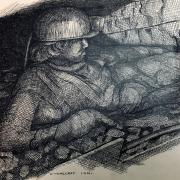A 750-year-old mystery death at Norton Priory near Runcorn may be more gruesome than historians expected
A researcher at the University of Liverpool has revealed that the skeleton of a 13th century knight buried at Norton Priory was killed by a sword cut to his upper back.
It had been believed the man, in his late forties, died from natural causes, but the recent discovery suggests a far more dramatic death.
A single sword blow to the upper back seems to have sliced through several vertebrae and would have caused terrible damage to the muscles and nerves in the man’s back. According to Shirley Curtis-Summers, the PhD researcher who discovered the injury, it would have been a mortal wound, but one that may have left him alive for several hours, yet unable to walk.
A battlefield injury might be expected for a knight of this period but Medieval weapons expert and TV presenter, Mike Loades, suggests a more sinister incident: ‘It seems almost inconceivable that a wound of this nature could be caused to anyone wearing armour. The slice would have had to cut through the armour for the entire length of the wound. This is not possible, which suggests this wound was not received in battle.
The possible scenarios that first occur to me are: assault by robbers or caught out, unarmoured, in an attack on his home or a private affray or murder.’
It seems a tragic end for a man who was evidently an important man and great benefactor of Norton Priory. Buried in a stone coffin with a lid bearing two carved shields that once would have borne his heraldic device, he took pride of place in the nave of the Priory church.
Curator Lynn Smith believes she may know who he was: ‘One character stands out as a strong possibility for being the occupant of this prestigious grave. That is Geoffrey Dutton, son of Adam de Dutton. We know he was born about AD 1170 and from skeletal evidence that he was 48 or over when he died.’
Whoever this poor man was, his story is one of many at Norton Priory which is the largest excavated monastic site in Europe. A new research programme is hoped to reveal many more such stories. The skeleton is now on display at Norton Priory Museum.
About Norton Priory
Award-winning Norton Priory Museum and Gardens is one of the largest excavated monastic sites in Europe. It is also home to a Georgian walled garden, orchards, the National Collection of Quince, woodland walks and a sculpture trail. The Museums and woodland garden are open all year except 24 – 26 December and 1 – 13 January.Norton Priory Museum and Gardens, Tudor Road, Manor Park, Runcorn WA7 1SX


























